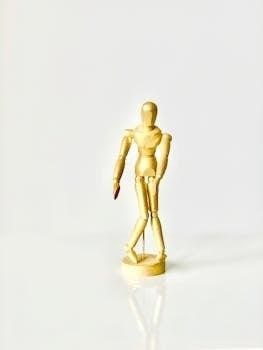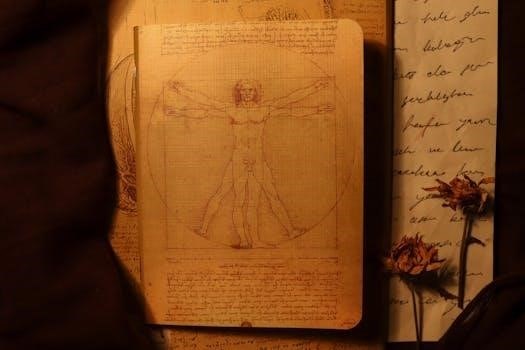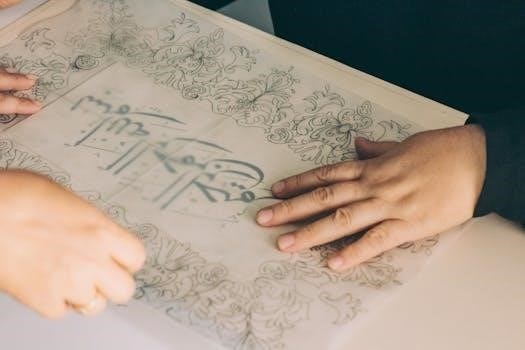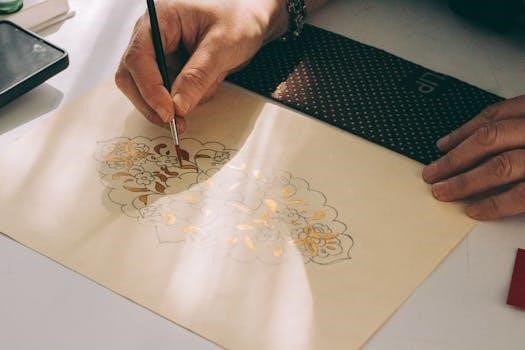Anatomy for Drawing PDF⁚ A Comprehensive Guide
Embark on an artistic journey, mastering the human form through comprehensive anatomy guides. Unlock the secrets of skeletal structure, muscular systems, and accurate proportions. Downloadable PDFs provide invaluable resources for artists seeking to elevate their figure drawing skills, enhancing understanding and artistic expression.
For artists, a solid grasp of anatomy transcends mere technical skill; it’s the foundation for creating believable, dynamic, and emotionally resonant figures. Anatomy for artists focuses on the aspects of human anatomy most relevant to visual representation, emphasizing form, proportion, and movement rather than intricate medical details. This introduction explores why studying anatomy is crucial for artists, regardless of their preferred style, from realism to stylized illustration.
Understanding the underlying structure of the human body, including bones and muscles, enables artists to construct figures with accuracy and confidence. Knowledge of anatomy allows artists to depict realistic poses, foreshortening, and weight distribution. Furthermore, it empowers artists to create compelling character designs and expressive figures that convey emotion and narrative effectively. Ignoring anatomy can lead to stiff, unnatural-looking figures that lack believability.

Anatomy provides a framework for understanding how the body moves and how muscles interact to create different poses and expressions. This understanding is essential for capturing the dynamism and fluidity of human movement. Whether you aspire to create realistic portraits, dynamic action scenes, or stylized character designs, a firm grounding in anatomy will significantly enhance your artistic abilities.
Understanding Skeletal Structure for Drawing
The skeletal system serves as the foundational framework upon which the human body is built. For artists, understanding this structure is paramount, as it dictates posture, movement, and overall form. The skeleton provides the underlying landmarks and anchor points for muscles, influencing the surface contours we observe. By studying the skeletal structure, artists gain a deeper understanding of how the body supports itself and interacts with its environment.
Key elements of the skeletal system crucial for drawing include the skull, rib cage, spine, and pelvis. The skull’s shape influences the head’s overall form and facial proportions. The rib cage protects vital organs and affects the torso’s shape and flexibility. The spine, a complex series of vertebrae, allows for a wide range of movement and dictates posture. The pelvis supports the upper body and connects it to the lower limbs, influencing hip and leg movement.
Understanding how these skeletal elements articulate and interact allows artists to create more believable and dynamic figures. Studying the skeletal structure helps artists accurately depict proportions, foreshortening, and weight distribution. Furthermore, it enables them to understand how the body responds to different forces and movements, resulting in more realistic and compelling artwork. Knowledge of skeletal anatomy is an invaluable tool for any artist seeking to master the human form.
Muscular System and its Impact on Form
The muscular system plays a critical role in shaping the human form and dictating its movement capabilities. Muscles overlay the skeletal structure, creating the visible contours and defining the body’s overall shape. Understanding how muscles attach to bones and interact with each other is essential for artists seeking to accurately depict the human figure.
Muscles work in opposing pairs to create movement. When one muscle contracts, its opposing muscle relaxes, allowing for a smooth and controlled motion. Key muscle groups for artists to study include those of the torso (such as the pectorals, abdominals, and obliques), the limbs (biceps, triceps, quadriceps, hamstrings, and calves), and the neck and shoulders (trapezius, deltoids, and sternocleidomastoid).
By understanding the origin and insertion points of these muscles, artists can accurately depict how they affect the surface form. When a muscle contracts, it becomes shorter and thicker, creating a bulge or contour that is visible on the skin’s surface. Conversely, when a muscle is relaxed, it appears elongated and less defined. Studying the muscular system allows artists to create more dynamic and realistic figures, capturing the nuances of human movement and expression. A deep understanding of muscle anatomy elevates figure drawing from simple representation to a true art form.
Proportions and Ratios in Human Anatomy
Achieving accurate proportions is fundamental to creating believable and compelling figure drawings. The human body adheres to certain proportional guidelines and ratios that, when understood and applied, contribute significantly to the realism of artwork. While individual variations exist, these guidelines provide a solid foundation for artists.

One common guideline is the “head height” measurement, where the overall height of the body is expressed in terms of the number of head lengths. Typically, an adult human is around 7.5 to 8 head lengths tall. This ratio can vary slightly based on age and individual build, but it serves as a reliable starting point. Other important proportional relationships include the ratio of shoulder width to hip width, the length of the arms and legs relative to the torso, and the placement of key anatomical landmarks.

Studying these proportions and ratios allows artists to avoid common mistakes such as drawing limbs that are too short or a torso that is disproportionately sized. By using these guidelines as a framework, artists can ensure that their figures appear balanced and anatomically correct. Remember that these are guidelines, not strict rules, and that observation and artistic interpretation are still essential for capturing individual nuances and creating dynamic, expressive figures. The human form is a masterwork of proportion, and its study is key.
Anatomical Landmarks for Accurate Drawing
Anatomical landmarks are crucial reference points on the human body that aid in accurate and realistic figure drawing. These are specific, palpable bony prominences or muscle insertions that are visible or easily felt beneath the skin. By identifying and accurately placing these landmarks in your drawings, you can ensure correct proportions, pose, and overall anatomical accuracy.
Key anatomical landmarks include the acromion process (the bony tip of the shoulder), the medial and lateral epicondyles of the humerus (at the elbow), the iliac crest (the upper border of the hip bone), the greater trochanter of the femur (at the hip), and the medial and lateral malleoli (at the ankle). These landmarks serve as anchor points for measuring distances, establishing angles, and understanding the underlying skeletal structure.
Using anatomical landmarks not only improves accuracy but also helps you to visualize the three-dimensional form of the body. By understanding where these landmarks are located beneath the skin, you can better represent the surface anatomy and create more convincing and dynamic poses. Practice identifying these landmarks on yourself and on live models to develop a strong understanding of their placement and relationship to one another. This knowledge will significantly enhance your ability to draw the human figure with confidence and precision, bringing your artwork to life with anatomical accuracy.
Drawing the Torso⁚ Anatomy and Movement
The torso, comprising the rib cage, spine, and pelvis, is the core of human movement and a complex anatomical region to draw accurately. Understanding its underlying structure is vital for capturing realistic poses and conveying a sense of dynamism in your figure drawings. The rib cage protects vital organs and influences the shape of the upper torso, while the spine allows for flexibility and a range of movements, including bending, twisting, and extension.
When drawing the torso, pay close attention to the rib cage’s elliptical shape and how it connects to the spine. The spine’s curvature, particularly the natural S-curve, affects the overall posture and balance. The pelvis, acting as a foundation, connects the torso to the legs and plays a crucial role in weight distribution and movement.
Consider how the torso moves as a single unit and how its different sections interact. When the figure bends, the rib cage compresses on one side and expands on the other. Twisting movements cause the spine to rotate, affecting the alignment of the shoulders and hips. Understanding these dynamic relationships will allow you to create more realistic and expressive drawings of the human figure in motion. Study anatomical references and observe live models to improve your understanding of the torso’s anatomy and movement capabilities.

Anatomy of the Limbs⁚ Arms and Legs
The limbs, arms and legs, are essential for movement, expression, and interaction with the environment, making their accurate depiction crucial in figure drawing. The arms consist of the upper arm (humerus), forearm (radius and ulna), and hand, while the legs comprise the thigh (femur), lower leg (tibia and fibula), and foot. Each segment has unique anatomical features and muscular attachments that influence its form and function.
When drawing the arms, pay attention to the bony landmarks, such as the elbow and wrist, and how the muscles of the upper arm (biceps, triceps) and forearm create volume and shape. The legs present a similar challenge, with the knee and ankle acting as key landmarks. The muscles of the thigh (quadriceps, hamstrings) and lower leg (calf muscles) contribute significantly to the leg’s overall form.
Understanding the range of motion of each joint – shoulder, elbow, wrist, hip, knee, and ankle – is vital for depicting realistic poses and movement. Consider how the muscles contract and relax during different actions, and how this affects the surface anatomy. Study anatomical references and observe the limbs in various positions to gain a deeper understanding of their structure and function, leading to more accurate and expressive drawings;
Head and Neck Anatomy for Portraiture
Capturing the essence of a subject in portraiture requires a solid understanding of head and neck anatomy. The skull’s underlying structure dictates the overall shape, while facial muscles create expressions. Key bony landmarks like the brow ridge, cheekbones, and jawline provide essential reference points for accurate proportions and realistic form.
The neck, connecting the head to the torso, is often overlooked but crucial for conveying posture and emotion. The sternocleidomastoid (SCM) muscle, running from behind the ear to the collarbone, is a prominent feature influencing neck shape and movement. Understanding its origin and insertion points helps depict head rotation and tilting accurately.
Facial muscles, though thin, dramatically impact expression. The orbicularis oris (around the mouth), orbicularis oculi (around the eyes), and frontalis (forehead) are key players in conveying emotions like happiness, sadness, and surprise. Studying their attachments and actions allows artists to capture subtle nuances and create compelling portraits. Paying attention to the interplay of bone, muscle, and skin is essential for realistic and expressive portraiture.
Resources for Anatomy Study⁚ PDF Downloads
Elevate your artistic journey with readily accessible anatomy resources! Numerous PDF downloads offer comprehensive guides to understanding the human form, essential for artists seeking accuracy and realism in their drawings. From detailed skeletal structures to intricate muscular systems, these resources provide invaluable insights.
Constructive Anatomy, a classic text, is available as a free ebook PDF, offering fundamental principles. “Drawing Human Anatomy” by Giovanni Civardi is another excellent resource, providing clear instructions and illustrative examples in PDF format. These downloads often include diagrams, charts, and explanations of anatomical landmarks, proportions, and movements.
Explore anatomy reference packs, such as those created by Jazza, to further develop your understanding. Many online platforms offer free or affordable anatomy guides tailored for artists, covering specific areas like the head, torso, or limbs. Enhance your knowledge and skills by utilizing these downloadable resources to improve your figure drawing techniques and create more compelling artwork. Remember to practice regularly, applying your newfound anatomical knowledge to your drawings.
Using Anatomy References in Figure Drawing
Anatomy references are indispensable tools for artists aiming to create realistic and dynamic figure drawings. They provide a framework for understanding the underlying structure of the human body, allowing you to accurately depict proportions, muscles, and skeletal landmarks. Begin by studying the skeletal structure to establish the foundation of your figure, paying close attention to the relationships between bones.
Next, consider the muscular system and how it influences the surface form. Observe how muscles attach to bones and create movement. Anatomy references help you understand how muscles bulge and contract, adding depth and realism to your drawings. Pay attention to anatomical landmarks such as the clavicle, scapula, and iliac crest, as these points are visible on the surface and aid in accurate placement of features.
When using references, avoid simply copying the image. Instead, focus on understanding the underlying anatomy and how it contributes to the overall pose and form. Practice drawing figures from various angles, using your anatomical knowledge to guide your hand. Remember, the goal is not to create a perfect replica but to develop a strong understanding of human anatomy that informs your artistic decisions and enhances your figure drawing skills.



